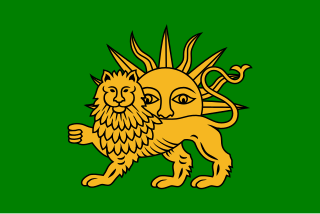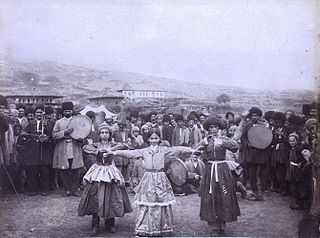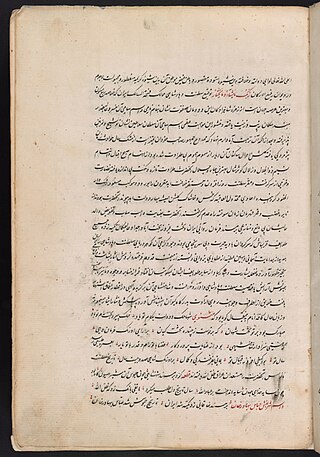Related Research Articles

The Safavid dynasty was one of Iran's most significant ruling dynasties reigning from 1501 to 1736. Their rule is often considered the beginning of modern Iranian history, as well as one of the gunpowder empires. The Safavid Shāh Ismā'īl I established the Twelver denomination of Shīʿa Islam as the official religion of the Persian Empire, marking one of the most important turning points in the history of Islam. The Safavid dynasty had its origin in the Safavid order of Sufism, which was established in the city of Ardabil in the Iranian Azerbaijan region. It was an Iranian dynasty of Kurdish origin, but during their rule they intermarried with Turkoman, Georgian, Circassian, and Pontic Greek dignitaries, nevertheless they were Turkic-speaking and Turkified. From their base in Ardabil, the Safavids established control over parts of Greater Iran and reasserted the Iranian identity of the region, thus becoming the first native dynasty since the Sasanian Empire to establish a national state officially known as Iran.

Tahmasp I was the second shah of Safavid Iran from 1524 until his death in 1576. He was the eldest son of Ismail I and his principal consort, Tajlu Khanum. Ascending the throne after the death of his father on 23 May 1524, the first years of Tahmasp's reign were marked by civil wars between the Qizilbash leaders until 1532, when he asserted his authority and began an absolute monarchy. He soon faced a long-lasting war with the Ottoman Empire, which was divided into three phases. The Ottoman sultan, Suleiman the Magnificent, tried to install his own candidates on the Safavid throne. The war ended with the Peace of Amasya in 1555, with the Ottomans gaining sovereignty over Iraq, much of Kurdistan, and western Georgia. Tahmasp also had conflicts with the Uzbeks of Bukhara over Khorasan, with them repeatedly raiding Herat. In 1528, at the age of fourteen, he defeated the Uzbeks in the Battle of Jam by using artillery.

Ismail I, also known as Shah Ismail, was the founder of the Safavid dynasty of Iran, ruling as its King of Kings (Shahanshah) from 1501 to 1524. His reign is often considered the beginning of modern Iranian history, as well as one of the gunpowder empires.

The Talysh people are an Iranian ethnic group indigenous to the Talish region shared between Azerbaijan and Iran which spans the South Caucasus and the southwestern shore of the Caspian Sea. They speak the Talysh language, one of the Northwestern Iranian languages. It is spoken in the northern regions of the Iranian provinces of Gilan and Ardabil and the southern parts of the Republic of Azerbaijan. The areas in the Republic of Azerbaijan where Northern Talysh is spoken was historically known as Talish-i Gushtasbi. In Iran there is a Talesh County in Gilan Province.

Sharaf al-Din Khan b. Shams al-Din b. Sharaf Beg Bedlisi was a Kurdish Emir of Bitlis. He was also a historian, writer and poet. He wrote exclusively in Persian. Born in the Qara Rud village, in central Iran, between Arak and Qom, at a young age he was sent to the Safavids' court and obtained his education there.

The Nakhichevan Khanate was a khanate under Iranian suzerainty, which controlled the city of Nakhichevan and its surroundings from 1747 to 1828.

Iskandar Beg Munshi was an Iranian court scribe and chronicler, who is principally known for his historical book of Tarikh-e Alam-ara-ye Abbasi, which focuses on early Safavid history, especially the reign of Shah Abbas I.

Shaykh Haydar or Sheikh Haydar was the successor of his father as leader of the Safavid order from 1460 to 1488. Haydar maintained the policies and political ambitions initiated by his father. Under Sheikh Haydar, the order became crystallized as a political movement with an increasingly extremist heterodox Twelver Shi'i coloring and Haydar was viewed as a divine figure by his followers. Shaykh Haydar was responsible for instructing his followers to adopt the scarlet headgear of 12 gores commemorating The Twelve Imams, which led to them being designated by the Turkish term Qizilbash "Red Head".

The province of Karabakh was a north-western province of the Safavid Iran, centered on the geographic region of Karabakh.
The Ordubadi family, otherwise known as the Nasiri family, was an Iranian family, which was descended from the medieval philosopher and polymath Nasir al-Din al-Tusi. The family was from Ordubad, a town which lay on the banks of the Araxes river, and is first mentioned during the Mongol invasions and conquests. The family thereafter disappears from sources, and is first mentioned several decades later when the Safavid dynasty conquered Iran and its surroundings in the 15th century. The leader of the family Bahram Khan Ordubadi, began serving the Safavid king (shah) Ismail I, who appointed him as the civil administrator (kalantar) of Ordubad.
Allahverdi Khan was a Safavid military officer of Armenian origin. He was the son of a certain Khosrow Khan, and had a brother named Emamverdi Beg.
Mohammad Khan Ustajlu was an Iranian military commander and official from the Turkoman Ustajlu tribe, who served during the reign of Safavid Shah Ismail I. He played a pivotal role in Ismail I's conquests and expansion in Asia Minor and Mesopotamia, and functioned as governor of the Diyarbakr Province from 1506 to 1514. Mohammad Khan was killed while serving as a commander at the Battle of Chaldiran.
The Divan-begi was a high-ranking official in Judicial system of Safavid Iran (1501–1736), who acted as chief justice of Safavid capital and all over the kingdom's courts. It was the Persian form of Turkic Diwan-begi office, also known as the Imperial Chief Justice or Lord High Justice. Divan-begis presided over an appeals court for the kingdom, except for cases involving military officers or religious officials. Divan-begis had deputies to assist them.

The Baghdad Province was a province of the Safavid Empire, centred on the territory of the present-day Iraq. Baghdad was the provincial capital and the seat of the Safavid governors.
Khadem Beg Talish was a Sufi and military commander of Talysh origin, who served the Safavid order, and later the dynasty established by the order, the Safavid dynasty. Khadem Beg was a retainer of Soltan Ali Safavi and his brother Ismail Mirza, when they were child, and an important advisor to the Shah Ismail.

The region of Talish was a governorate of Safavid Iran (1501–1736), located in the greater Talish, presntly divided between Iran and Azerbaijan. The territory of the governorate was principally made up of the two subordinate governorates of Astara and Lankaran. The city of Astara was its administrative center, the base of Safavid power in the region.
Mirza Mohammad Mihrani known as Mirza Mohammad Talish was an Iranian nobleman and prominent military commander of Talysh origin. He was a descendant of Mihranids and his ancestors were the hereditary governors of Astara. Mirza Mohammad was the governor of Astara, and later became the Safavid governor of Yazd. He was married to a sister of Sultan-Ali Beg Chākirlu, the Aq Qoyunlu governor of Ardabil.
Mohammad Beg Talish was a dignitary military commander of Talysh origin, who resided in Khalkhal and served the Safavid order. He married with Shah-Pasha Khatun when her father, Shaykh Junayd, was alive. Shah-Pasha Khatun was the only surviving sister of Shaykh Haydar (1459–1488). This marriage bring an alliance which helped the Safavid dynasty during the last phase of their struggle for power.

The province of Khuzestan was a southwestern province of Safavid Iran, corresponding to the present-day province of Khuzestan.